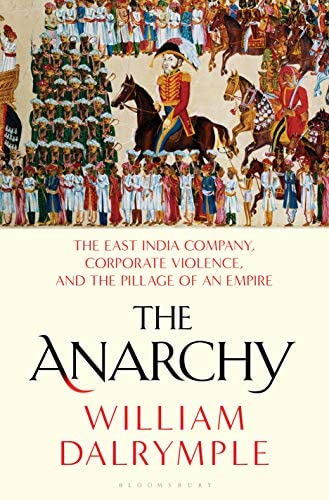Dalrymple, William. The Anarchy: The East India Company, Corporate Violence, and the Pillage of an Empire. New York: Bloomsbury, 2019.
Early on in my study of the British Empire, I had the pleasure of reading William Dalrymple’s Return of a King in an undergraduate independent study. Dalrymple’s masterful telling of the events of the First Afghan war made an appearance here on Concerning History in my first “Episodic History” post, and has even made its presence felt on my gaming table through Cole Werhle’s fantastic boutique boardgame Pax Pamir. Ironically, or perhaps fittingly, it took the second edition of Werhle’s original game John Company to remind me that Dalrymple has since written another book about the East India Company, this time covering the half century when it established itself as master of the Indian subcontinent. Finally, in January of 2023, I dove into The Anarchy.
In 1750, the Mughal Empire reigned supreme in India; challenged only in the southwest by the Maratha Confederacy’s impregnable hilltop fortresses and light guerilla cavalry. Along the coast, a small trading company based in London depended upon imperial largesse for the trading privileges that made their efforts so profitable. By 1810, positions had been reversed: the East India Company ruled most of the subcontinent as a territorial state, while the last Mughal Emperors sat in powerless splendor in Delhi at the sufferance of the Company. Dalrymple guides his readers along the tumultuous path that resulted in this remarkable chain events, from the decline and collapse of Mughal power to the internecine strife between its successor states to the key British players that exploited the opportunity to transform their mercantile efforts into something much more profitable–and imperial.
Dalrymple’s framing for this narrative is, fittingly, one that resonates in our modern era of mega-corporations and late-stage capitalism: the oddity of millions of Indians coming under the direct rule of not a government but a company, an entity concerned not with responsible governance but profits, governed by a board of directors headquartered thousands of miles away in London. Dalrymple ties this phenomenon directly to the ruthless extraction of wealth from the subcontinent, especially the impoverishment of what had been the wealthiest Mughal province, Bengal. Yet the EIC is not the only rapacious organism that makes an appearance in The Anarchy. The period is so named in contemporary sources in large part due to the breakdown of law and order across the subcontinent, seen most notably in the repeated sacking of Delhi at the hands of Persian, Afghan, and Maratha forces. Indeed, it seems the motivating factor of any aggressor of the period, either EIC and native, was the loot to be gained from the defeated. Actually sitting back and looking at Dalrymple’s narrative in the round, therefore, seems to actually undermine his theme of corporate peculiarity; while the Company is not behaving as an Enlightened government should, it is arguably behaving no differently than its competitor empires on the subcontinent: only concerned with personal wealth and aggrandizement, common people be damned. Ironically, in this light the EIC comes off rather well. Many of Dalrymple’s sources recognize the stability Company rule brought to areas under its control, even while lamenting the abuses of its tax collectors in the next breath. Nor does the specter of distant rule hold up upon close examination; yes, technically Company officials were beholden to the Board of Directors, but nearly every consequential decision in Dalrymple’s period is actually taken by governors or governors-general on the ground in India, many times in opposition to the wishes of the Board if they had been consulted.
Though these missed opportunities prevent The Anarchy from being truly groundbreaking, Dalrymple remains a brilliant and engaging historian of British India, and any seeking to learn about one of the more pivotal half-centuries in world history should find themselves well satisfied. I personally can only dream of a future third installment of this unofficial trilogy covering the Indian Rebellion of 1857. As it is, The Anarchy will take its place among my own series of excellent popular history studies tracking the course of the 18th- and 19th-century British Empire.
